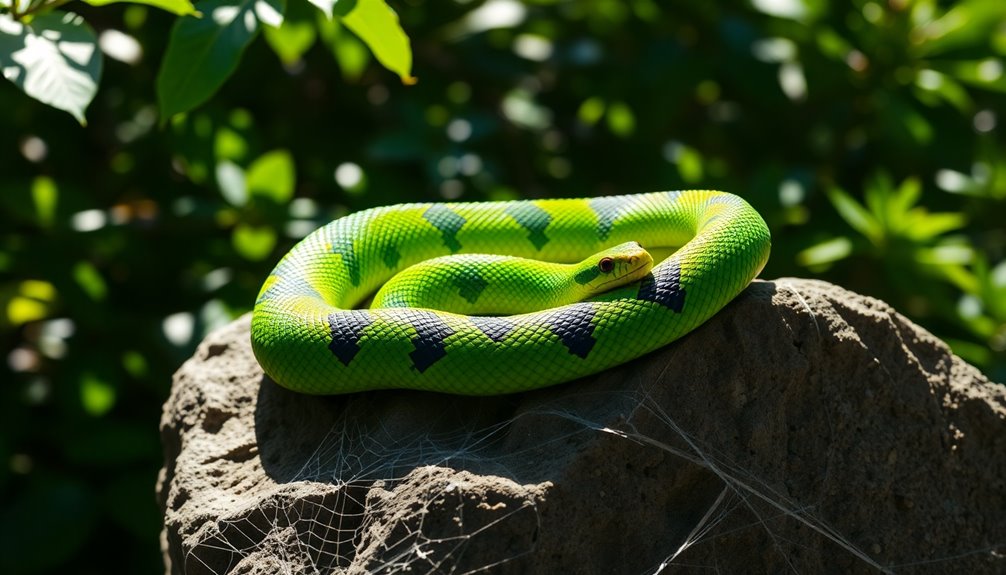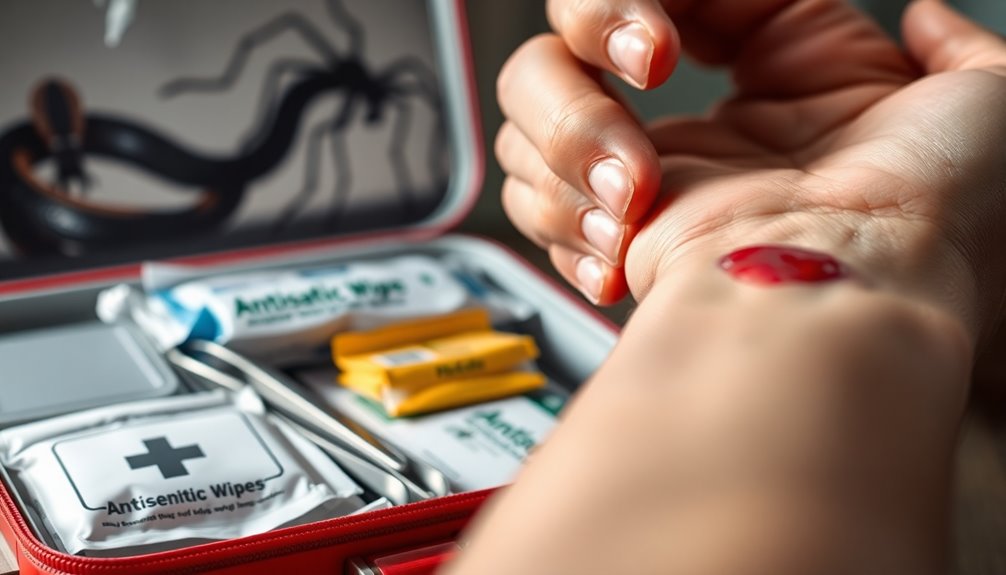To stay safe from venomous snakes, you need to be aware of your surroundings and know what to look for. In the U.S., watch for rattlesnakes, copperheads, cottonmouths, and coral snakes. They often have triangular heads and distinctive markings. Avoid tall grass and thick underbrush, especially during warmer months when snakes are more active. Wear sturdy boots and consider gaiters for extra protection. If you encounter a snake, stay calm and back away slowly. Understanding these basics can significantly reduce your risk of bites and help you enjoy the outdoors safely while uncovering more essential tips for your safety.
Key Takeaways
- Learn to identify venomous snakes by their triangular heads, elliptical pupils, and distinctive features like rattles or vibrant color patterns.
- Stay alert in warmer months, wear protective gear, and stick to marked trails to avoid accidental encounters with snakes.
- Use hiking poles to probe ahead in tall grass or brush, helping to clear paths and spot snakes early.
- If bitten, seek immediate medical attention and immobilize the affected limb while remaining calm to reduce venom spread.
- Educate yourself on local snake species and behaviors to enhance awareness and minimize risks during outdoor activities.
Introduction

When you're outdoors, knowing how to identify venomous snakes can keep you safe.
Recognizing their distinctive features helps you avoid potential danger while enjoying nature.
Let's explore key traits and tips to ensure your outdoor experiences remain enjoyable and incident-free.
Identifying Venomous Snakes Quickly
Identifying venomous snakes quickly can be crucial for your safety in the wild. In the U.S., four main types of venomous snakes exist: rattlesnakes, copperheads, cottonmouths, and coral snakes.
To identify these snakes, look for key features. Venomous snakes typically have triangular heads and elliptical pupils, while non-venomous snakes have rounded heads and round pupils.
Pay special attention to pit vipers, like rattlesnakes, which possess heat-sensitive pits between their eyes and nostrils, aiding in hunting warm-blooded prey. Rattlesnakes also have a distinctive rattle that warns you of their presence.
Ensure Safe Outdoor Experiences
Outdoor adventures can be exhilarating, but ensuring your safety is paramount. Maintain awareness of your surroundings, as most snake bites happen during accidental encounters.
Snakes love warm weather, so stay alert when hiking in spring, summer, and fall, and avoid tall grass and dense underbrush. When you're in snake-prone areas, wear sturdy, ankle-high boots and long pants to reduce your risk.
A flashlight during nighttime hikes can help you spot snakes from a safe distance, allowing you to navigate more safely. Educate yourself about local snake species to distinguish venomous vs. non-venomous ones, enhancing your ability to avoid a snake.
Lastly, always know basic first aid in case of an encounter—being prepared can make all the difference.
Snake Identification Basics

Knowing how to identify venomous snakes is crucial for safety, especially in the U.S. where approximately 7,000-8,000 bites are reported each year.
Understanding snake identification basics can help you avoid dangerous encounters. Start by looking for key features: venomous snakes often have triangular heads and elliptical pupils.
Rattlesnakes, the most common venomous snakes, are easily recognized by their distinctive rattle, which warns you to stay away.
Coral snakes, part of the cobra family, display vibrant red, yellow, and black banding.
Remember, non-venomous snakes usually have rounded heads and round pupils.
Essential for Outdoor Survival
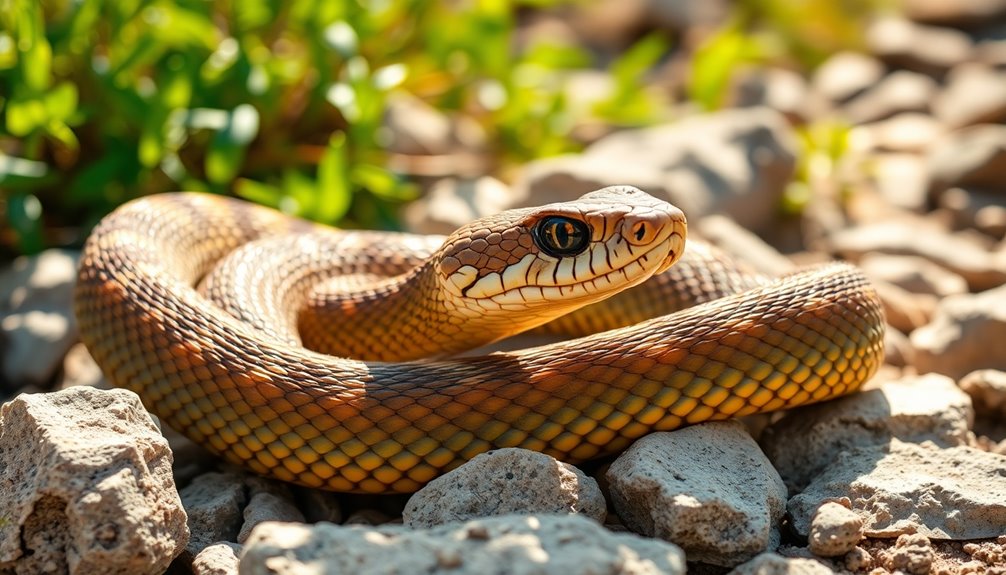
When you're out in the wild, knowing the local venomous snakes can be a lifesaver.
Familiarizing yourself with rattlesnakes, copperheads, cottonmouths, and coral snakes helps you prevent life-threatening injuries.
Preventing Life-Threatening Injuries
A few simple precautions can significantly reduce your risk of life-threatening injuries from venomous snakes while hiking.
First, wear ankle-high leather boots and long pants, especially in known snake habitats, as this gear can help prevent snake bites.
Always stay on marked trails and avoid dense underbrush, which snakes often favor for shelter.
Maintaining awareness of your surroundings is crucial, particularly during spring, summer, and fall when snakes are most active.
Using hiking poles to probe ahead in tall grass or brush can help you detect snakes before you step on them.
If a snake bite does occur, it's vital to seek medical attention immediately.
Local Snake Species Awareness
Understanding the local snake species in your area can significantly enhance your outdoor safety. In South Carolina, for instance, there are 38 snake species, including five venomous snakes like rattlesnakes, copperheads, and cottonmouths.
Familiarizing yourself with their characteristics is crucial for proper identification. Venomous snakes often have triangular-shaped heads, elliptical pupils, and heat-sensitive pits. While these pit vipers prefer to avoid confrontation, knowing how to spot them can help you avoid an encounter.
Coral snakes, though highly venomous, are shy and rarely bite. By understanding the local snake species and their habits, you'll increase your awareness, promote safety, and reduce the chances of accidental encounters while hiking in the great outdoors.
Avoid Tall Grass Areas
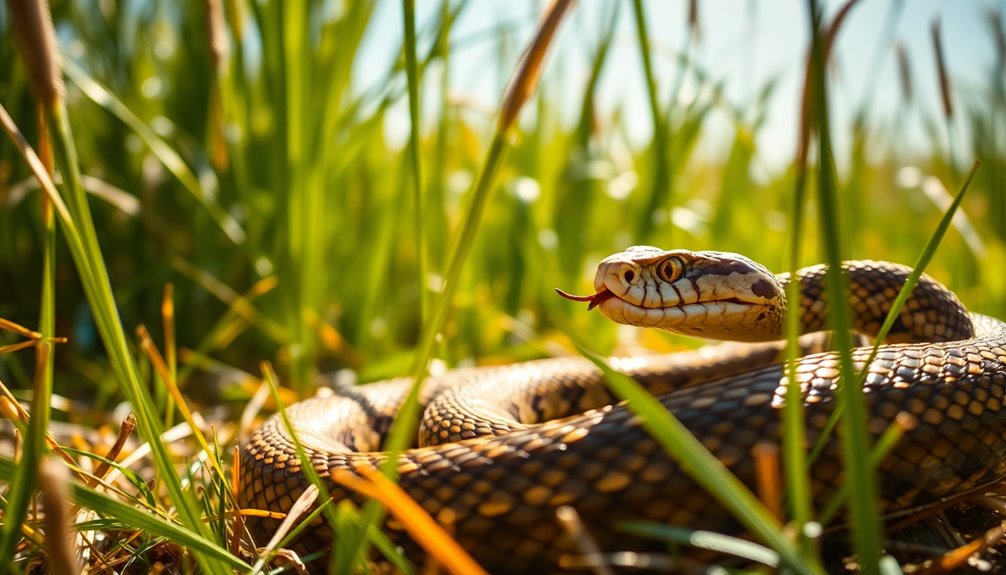
Tall grass can be a hidden danger for hikers and outdoor enthusiasts. To minimize the risk of encountering a snake, it's crucial to avoid tall grass areas.
These spots provide perfect hiding places for snakes, especially during warmer months when they're most active. While many snakes are harmless, some venomous species prefer to remain concealed in dense grass.
To stay safe, always stay on marked trails, which are usually maintained and free of tall grass. If you must navigate near these areas, make noise to alert snakes of your presence; they typically prefer to flee rather than confront you.
Safety Gear Recommendations
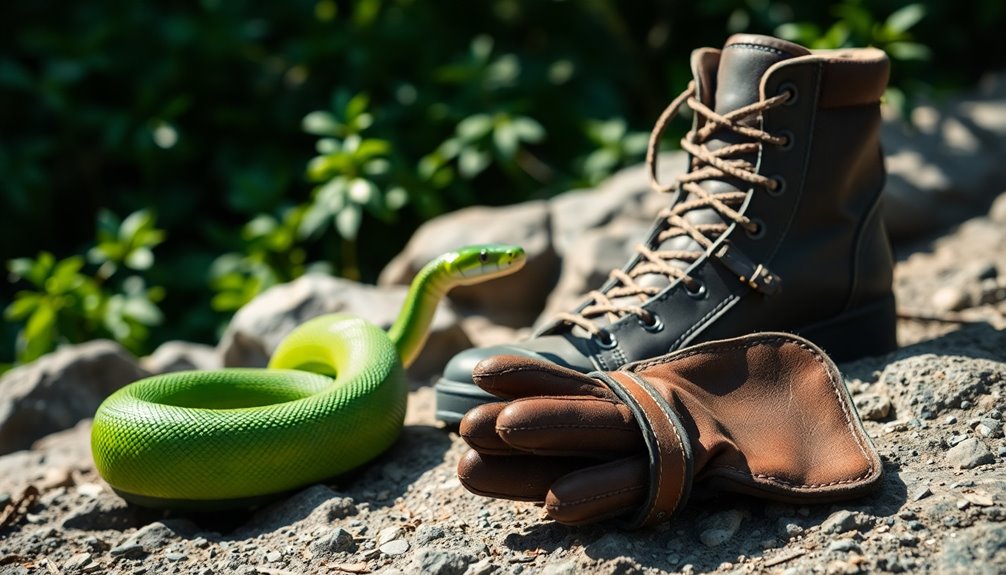
How can you effectively protect yourself from venomous snakes while enjoying the great outdoors?
Start by investing in quality safety gear. Wear ankle-high leather boots to shield your feet and ankles from potential bites. Opt for long pants made from thick fabric to minimize skin exposure, reducing the risk of snake encounters.
If you're hiking in areas with tall grass or dense underbrush, consider adding shin guards for extra protection. A sturdy hiking pole is essential, as it allows you to check the ground ahead and clear paths, helping you avoid unexpected encounters.
Lastly, don't forget a reliable flashlight for night hikes; spotting snakes in advance can significantly improve your safety while navigating the trails.
Snake Awareness and Preparedness

Even with the right safety gear, staying aware of your surroundings while outdoors is vital for avoiding encounters with venomous snakes. By practicing snake awareness, you can significantly reduce the chances of surprising or provoking these reptiles.
Stick to well-trodden paths and avoid tall grass or dense underbrush, as these areas are common habitats for rattlesnakes, cottonmouths, and copperheads.
When hiking at night, always carry a flashlight to help detect snakes early, allowing for timely avoidance.
Remember, even if a snake bite feels minor, around 25-40% of bites are dry; it's crucial to seek medical attention promptly.
Implementing these preventative measures will enhance your safety and enjoyment during outdoor adventures.
Identifying Snakes in Low Light
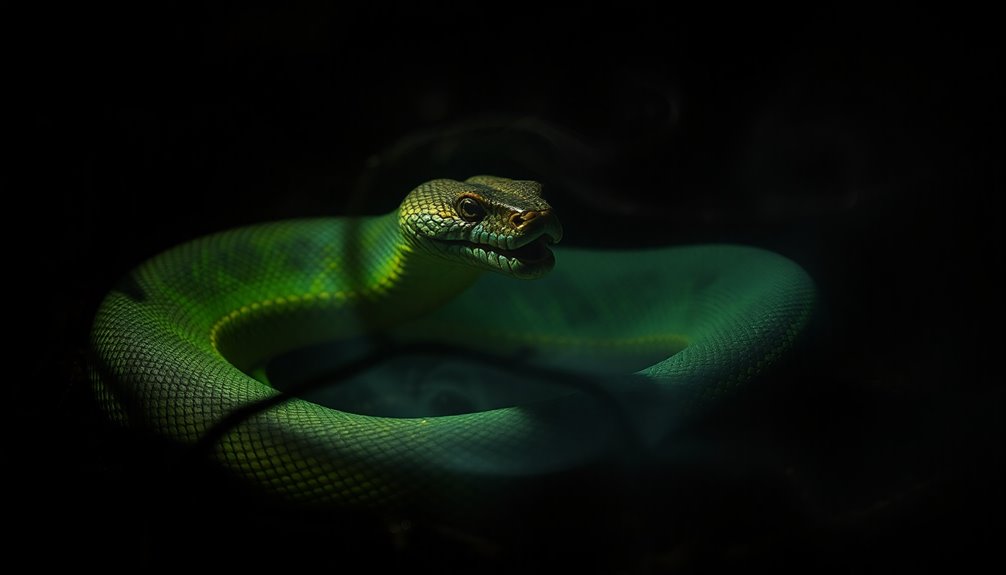
When identifying snakes in low light, it's crucial to understand their seasonal behavior patterns, as this can influence when and where you might encounter them.
Wearing protective snake gaiters can also keep you safe while you navigate through areas where snakes might be hidden.
Stay alert, and use your flashlight wisely to spot any potential threats.
Seasonal Snake Behavior Patterns
During the warmer months, you're likely to encounter snakes more frequently, especially in low-light conditions like early mornings or late evenings.
Seasonal snake behavior shows that many species, including venomous snakes like rattlesnakes and cottonmouths, become more active during spring and summer. They often sunbathe on flat surfaces, making them easier to spot during twilight.
When you go on nighttime hikes, carrying a flashlight is essential, as snakes can blend into their surroundings in low light.
Be aware of your terrain, particularly potential hiding spots like brush piles or tall grass, to help prevent unexpected snake encounters.
Wear Protective Snake Gaiters
Wearing protective snake gaiters significantly enhances your safety while hiking in areas where venomous snakes are present, especially in low-light conditions.
These gaiters act as a barrier against snake bites, providing an additional layer of protection against fangs from venomous species like rattlesnakes and cottonmouths. They're designed to cover your lower legs, effectively reducing the risk of serious injury during encounters.
It's important to choose gaiters made from durable, bite-resistant materials, as traditional clothing often doesn't suffice. In low light, gaiters improve your visibility and awareness, reminding you to watch your step.
Pairing gaiters with a flashlight allows you to identify snakes more easily, ensuring you stay safe while hiking.
Hiker Bitten by Rattlesnake
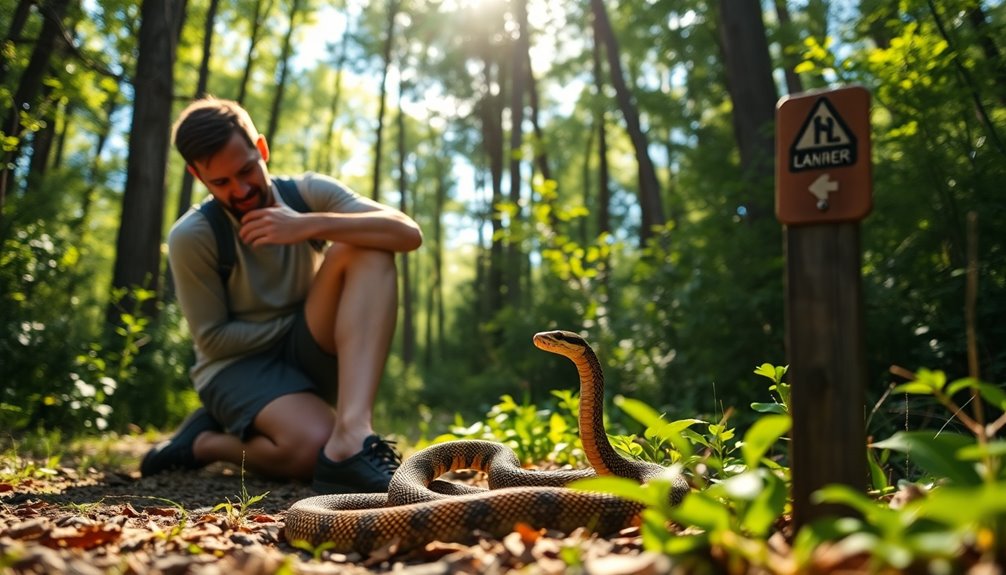
A hiker's unexpected encounter with a rattlesnake can turn a serene trek into a medical emergency. If you get bitten, it's crucial to seek immediate medical attention.
Rattlesnake bites often happen when you accidentally provoke or surprise the snake, especially when stepping off marked trails or reaching into dense vegetation. Symptoms like swelling, pain, and discoloration can escalate rapidly, so stay calm and immobilize the bitten limb.
Remember, about 25-40% of rattlesnake bites are "dry bites," meaning no venom is injected, but all bites still need evaluation. Excessive movement can spread venom through your bloodstream, making the situation worse.
Rattlesnake bites account for many snakebite fatalities in the U.S., so treat every bite seriously.
Conclusion

As you venture into the great outdoors, understanding venomous snakes is vital for ensuring your safety. Knowing how to identify them—by their triangular heads and elliptical pupils—can help you avoid potential snake bites.
Most venomous snakes shy away from humans, but awareness of their behavior and habitats will greatly reduce your chances of an encounter. If you do get bitten, immediate medical attention is essential; timely care from medical professionals can prevent severe injury or even death.
Additional Resources
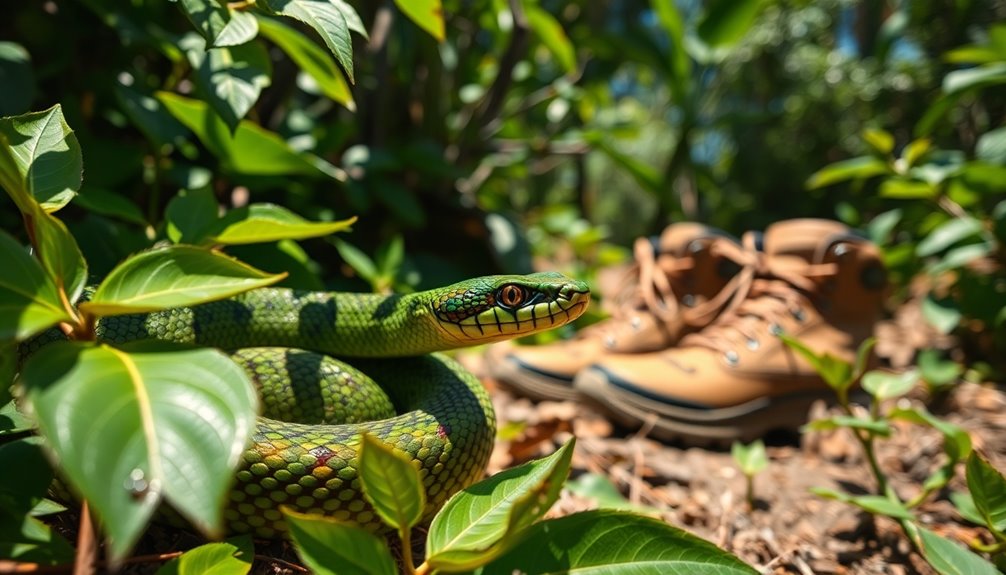
Understanding venomous snakes is just the first step in ensuring your safety outdoors; having access to reliable resources can further enhance your knowledge.
The Savannah River Ecology Laboratory offers valuable research and educational resources on local snake species, improving your awareness of their behaviors.
The Virginia Herpetological Society provides insights into identifying venomous and non-venomous snakes in your area, while Wikipedia delivers comprehensive articles on pit vipers, detailing their characteristics and habitats.
For deeper insights, the Center for North American Herpetology focuses on snake behavior and ecology, informing your outdoor practices.
Additionally, Wild Snakes: Education and Discussion hosts Facebook groups and Live events, offering community support and safety tips for navigating snake encounters effectively.
Frequently Asked Questions
What Is the Rhyme for Coral Snakes?
To identify coral snakes, you can use the rhyme: "Red touches yellow, kills a fellow; red touches black, friend of Jack."
This helps you distinguish between venomous coral snakes and non-venomous look-alikes like milk snakes.
Remember, if the red and yellow bands are touching, it's venomous, but if red and black are next to each other, it's safe.
Just keep in mind this rhyme only applies to North American species!
What Can You Do to Prevent a Snake Bite if You Encounter a Snake?
To prevent a snake bite when you encounter a snake, stay calm and back away slowly.
Keep your distance, as most bites happen when snakes feel threatened. Wear sturdy boots and long pants to protect yourself.
Stick to marked trails and avoid tall grass where snakes might hide. Use hiking poles to check for snakes in your path.
Finally, stay alert and listen for any warning sounds, like rattling.
Where Is the Most Dangerous Place to Grab a Snake?
The most dangerous places to grab a snake are definitely the head and neck. This is where they can strike with lightning speed if they feel threatened.
Even if a snake seems calm, it can react quickly if you handle it improperly. Instead of attempting to grab one, you should keep your distance and observe it from afar.
How to Survive an Encounter With a Snake?
If you encounter a snake, your best move is to stay calm and slowly back away.
Most snakes don't want to engage and will retreat if given the chance. Try to identify its characteristics, but don't get too close.
If bitten, keep the affected area still and below heart level while seeking medical help immediately.
Avoid common myths like applying ice, as they can make the situation worse.
Stay safe and vigilant!

